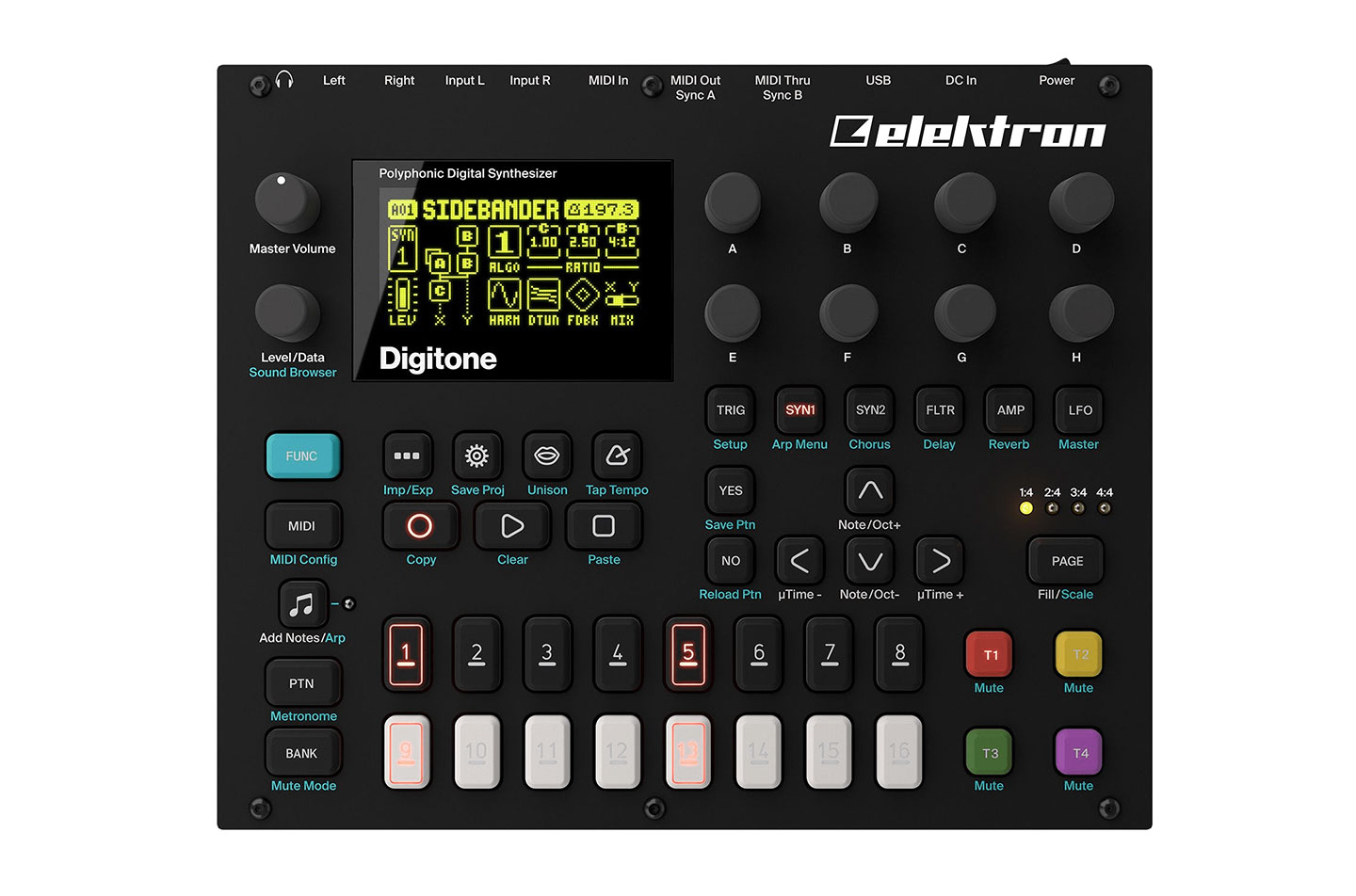- FM synthesis with an Elektron sequencer is a match made in sound design heaven.
- Frequency modulation synthesis, or FM, is notoriously difficult to program. But while it's certainly more complicated than typical subtractive methods, the interface of early FM synths made things much harder than they needed to be. Yamaha's DX series in particular was in dire need of knobs. The front panel was dominated by confusing graphics while the controls were limited to a pair of sliders, rows of buttons and a tiny screen. Elektron's new Digitone takes a better approach, providing a more accessible interface without dumbing down FM's sound design potential. It's much easier to program than any DX series device, but it's still a fully-fledged Elektron machine—if you want to go deep with it, your curiosity will likely be rewarded.
The Digitone appeared in the midst of an ongoing FM renaissance, which shows no signs of slowing down despite the ongoing obsession with all things analogue. Elektron aren't mere FM revivalists, however. The Machinedrum and Monomachine were FM powerhouses back when the technique was hardly trendy. Cosmetically, it's nearly identical to the Digitakt, save some colour scheme and button location differences. It also retains most of the Digitakt's interfacing and sequencing elements, making it easy to adopt for anyone familiar with the current Elektron UI.
At its heart, the Digitone is a four-part synthesiser with eight-voice polyphony and a four-track MIDI sequencer. The voice distribution and configuration is refreshingly simple. In fact, the voice settings have their own button, which is no small feat for an Elektron box. Synth patches can either be stored locally per project or in the globally accessible Sound Pool. Thanks to the advanced voice-stealing and distribution system in play here, whole synth patches, rather than just operators and mod-indices, can be parameter-locked per step. In practice, this means the Digitone can be a powerful glitch machine before you even start programming your own patches.
Korg's Volca FM made waves a couple years ago with its easier approach to FM programming, but the Digitone's no slouch either as far as user-friendly patching goes. It's flavour of FM is based around a particular four-operator structure, referred to as A, B1, B2 and C. That's nothing too unusual by FM standards, but it does have its quirks. Firstly, C is always a carrier and is limited to integer ratios for the most part; second, B1 and B2 have linked but different ratio controls and share an envelope/mod index. The Digitone offers eight algorithms, but each algorithm has two outputs, X and Y, and a handy crossfader for mixing between the two. The last of the notable FM implementation features is the harmonic control, which is basically a whole other synthesis engine in itself. It uses additive synthesis to add partials to either the carrier or A and B1. Even without any FM, controlling the harmonics with the likes of an LFO creates a solid impression of a wavetable synth.
There's been a fair amount of chatter regarding the decision to give each voice not just one but two filters (a multi-mode and a bandpass). Purists may scoff at the idea of rolling off all those hard-earned harmonics through a lowpass filter, but it's a nice consolation to FM newbies, and Elektron's got a knack for filter design, so why not?
Each sound on the Digitone has a total of four envelope generators, one each for A and B's modulation indices, one for the multi-mode filter, and of course, an amplitude envelope (not to mention a pair of LFOs per track that can be triggered in one-shot mode). This is more or less par for the course with FM, since audio-rate modulation is only so interesting if you're able to vary the modulation depth over time.
Elektron took a somewhat deviant approach to the mod envelopes, eschewing both a standard ADSR and the highly complex contour generators of the DX school in favour of an AD(S)E, or attack-decay-end, envelope. The main difference between an AD and an ADE envelope is that rather than decaying to silence, you can adjust the ending amplitude level. The modulator envelopes can also run in gated mode, where a sustain phase at max volume follows the attack for as long as the note is held. It's not a bad setup, but the envelopes could be more flexible—my main gripe is with the hardwired linear attack/exponential decay. This decision is confusing seeing as both the Octatrack and Analog Four offer at least switchable attack curves, but it's entirely possible this could change with a future OS update.
That said, it's hard to take issue with the Digitone. The FM implementation is versatile enough that you can come up with nearly any sound you need, and the interface means programming sounds doesn't require constant peeks in the manual or too much head-scratching. Though inevitable compromises were made in choosing what features should be user-programmable, this is still an extremely heavy synthesiser that should satisfy your strangest FM desires. We haven't even mentioned the power of combing this with the beloved Elektron sequencer and polyphonic MIDI capabilities, but this is a testament to how good the FM engine is all on its own. Plus, it seems to have gotten FM godfather John Chowning's seal of approval, so how bad could it be?
Ratings:
Cost: 4.1
Versatility: 4.5
Ease of use: 4.2
Sound: 4.8
